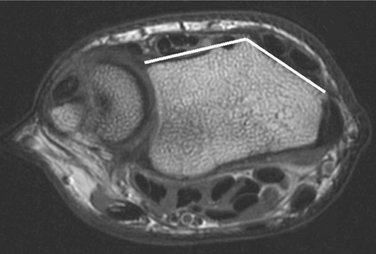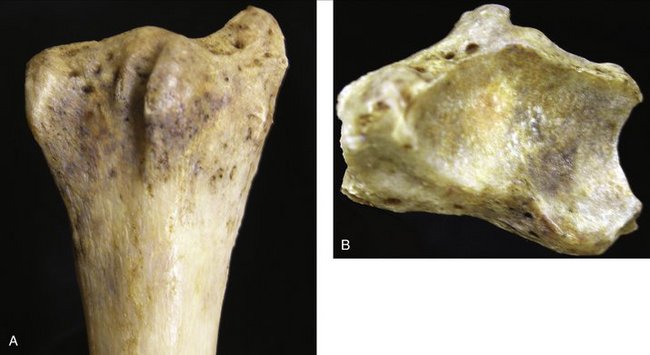CHAPTER 16 Complications of Locked Volar Plates
Volar plating with locked plates has dramatically reshaped the treatment of distal radius fractures. Along with any new technique come new complications, and locked volar plating is no exception. Complications of locked volar plating reported in the literature, at national and international presentations, in online discussion forums, in my personal cases, and in cases submitted for review to me have included:
Analysis of Complications
Tendon Irritation or Rupture from Pastpointing of Distal Screws
The dorsal cortex of the distal radius can be thought of as being composed of two surfaces, one radial and one ulnar to Lister’s tubercle. In the MR image shown in Figure 16-1 the two surfaces form a dihedral angle of approximately 140 degrees (see also Fig. 16-3), neither of which is parallel to the plane of a lateral radiograph. Therefore, the lateral radiograph will not profile either of the dorsal distal radial surfaces. Even if the profile of Lister’s tubercle is ignored, a lateral view of the distal radius will not be able to determine if the screw is extending beyond the dorsal cortex. This brings up several additional points.
The second point is that extensor tendons are less than 1 mm away from the dorsal cortex, separated from it by only a thin layer of periosteum. Pastpointing by only 1 mm will bring the screw into contact with the tendons. The earliest locked volar plates used standard orthopaedic screws. Their cutting flutes are on the order of 2 to 3 mm and are particularly dangerous. Many of the current generation of locked volar plates use custom distal locking screws, with a taper on the leading end on the order of 1 mm and much smaller cutting flutes. Traditional orthopaedic practice has been to have the screw pastpoint beyond the cutting flutes and/or screw tip taper to obtain optimal purchase on the far cortex. This practice in locked volar plating will bring the screw tip into contact with the extensor tendons. Even screws designed without a formal cutting flute will have a tapering thread, to start the thread into the bone. This leading edge of the thread can be problematic if it comes in contact with the tendons, which are forced against the dorsal cortex whenever the patient performs simultaneous wrist flexion and finger extension.
The third point, returning to an analysis of the distal radial anatomy and the lateral radiograph, is that even oblique views of the distal radius, such as obtained with intraoperative mini-fluoroscopy, cannot easily define the location of the dorsal cortex, because some tendons, particularly the extensor pollicis longus (EPL), lie in a slight indentation in the dorsal cortex (Fig. 16-2).
A fourth point is that there is no need to attempt to place the screws beyond or even close to the dorsal cortex. As observed earlier, the “distal cortex” is the subchondral bone. An examination of the lateral radiograph (see Fig. 16-8, later) shows that the subchondral bone stops several millimeters shy of the dorsal cortex. A screw can fully support the subchondral bone and yet stop 2 to 4 mm short of the dorsal cortex.
Case Examples
A 65-year-old woman fell and sustained a distal radius fracture. A locked volar plate was placed and intraoperative fluoroscopy indicated proper distal screw placement: just below the subchondral bone, out of the joint, and screw tips just below the dorsal cortex. Plain films were taken (Fig. 16-3A) and demonstrated a slight ulnar placement of the plate but good purchase on the dorsal ulnar corner and adequate purchase of the radial styloid on the posteroanterior view and good placement of the distal screws—just below the subchondral bone, out of the joint, and screw tips just below the dorsal cortex—on the lateral facet view.
Follow-up plain films in the office, probably with a slightly different rotation, indicated that the screw tips were just penetrating the dorsal cortex but seemed appropriate at the time on review by several orthopaedic surgeons (see Fig. 16-3B).
However, the patient complained about wrist stiffness and pain more than most patients. There was absolutely no localizing tenderness along the dorsal radius to suggest screw prominence, and there was no irritation with finger range of motion. After several visits without improvement in symptoms or change in the physical examination to suggest screw prominence, computed tomography (CT) was performed (see Fig. 16-3C).
In a different case (Fig. 16-4A), note how much tendon damage was done by a screw in precisely the wrong place—directly below the EPL tendon, with only 1 mm of pastpointing (see Fig. 16-4B). Even minimal pastpointing can be disastrous if screws are positioned in the wrong place!











